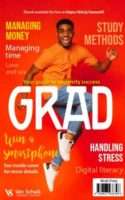THE POMODORO TECHNIQUE
In order to study effectively, and beat procrastination at the same time, you can structure your study time according to what is known as the pomodoro technique (Francesco Cirillo, the Italian who came up with it, had a tomato-shaped kitchen timer – the word “tomato” is pomodoro in Italian.)
Set your phone or a stopwatch for 25 minutes. Work with focused attention for those 25 minutes. Everything else is turned off.
When the timer goes off, relax for five minutes. Do something fun, take a power nap, dance to your favourite song.
Repeat the process three more times – for a total of two hours.
Then take 30 minutes off. This time off allows your brain to go into diffuse mode, which helps to lay down the new pathways for new learning and may even help you see a solution to something you had been struggling with in the focused time.
Start again with a set of four “pomodoros” – 25 minutes focused mode, 5 minutes relaxation, etc.
CHUNKING
Professor Oakley stresses that our working memory is a limited resource. It only has four slots, she says. It is not possible to hold too many ideas at the same time.
In fact, you actually weaken your thought process when you try to multitask. Careful, focused attention is very important. It also helps to “chunk” related bits of information together in larger wholes.
Memory is aided by our natural tendency to see patterns and make connections. New bits of information are like puzzle pieces: all over the place, taking up a lot of space in your working memory.
Once you have grasped the overall picture, it is much easier to handle the information. Start putting together sections of the material as you would when building a jigsaw puzzle – first find the edges, then select the green pieces and build the tree, select the white pieces and build the house under the tree, and so on. The edges give you the overall structure. Soon you will see how the “chunks” fit into that frame, and how they relate to each other. Over time you build up a library of chunks and you can make connections between them, even between different subjects
SPACED REPETITION
How do you transfer knowledge or understanding from your working memory into your long-term memory? The same way you would learn a song: practice. Practice makes permanent. The more you practice, the wider and the more embedded the neural pathways become. If you don’t practice, the patterns vanish before they are made permanent.
The best way to practise your new knowledge is by spaced repetition. You may want to Google this term. There are many articles and videos that will help you understand how best to employ the technique. Most of the following ideas come from a video on www.collegeinfogeek. com, but there are many others.
Spaced repetition means going back to the same material again and again, but with bigger gaps between the sessions. A good pattern is to revisit it after one day, after seven days, and after 14 days, and then again when studying for a test. You can make it even more effective by testing yourself on the different chunks/problems/sections of the information every time. Those you get right are put aside for next time. Those you get wrong have to be revisited tomorrow. Only when you know them well can you extend the period before you go back to them.
Cramming the material once may get you through a test, but if that’s all you do you will have to start from scratch when you get to the exam. That is not an efficient use of your total study time. If you apply spaced repetition, you will spend less time in total on the material to get to the same level of understanding and retention. Research about the “forgetting curve” illustrates this very clearly. You can see below that the more times you go back and revise something, the longer it will stay in your memory. (Source here):

LEARN BY TEACHING
We learn much better when we learn to teach others. Working in a study group gives you the opportunity to take responsibility for a part of the work and present it to the rest of the group.
Even with all of these theories in your mind, you can study all day long while simply spinning your wheels. You may develop what Professor Oakley calls “illusions of competence in learning” – a frightening thought! Here are a few practical pointers to help you avoid that:
Test yourself all the time. Make flash cards with a question/problem on one side and the solution on the other.
Never do it only once. Repeat the information/process/formula until it flows like a song. Don’t only do a homework problem once. Pick some of the key ones, do them again, see if you can do them in your head. Learn them like a song.
Don’t only highlight or reread information. Look at the page, then look away, and see what you can recall.
Explain the material to someone else (or even out loud to yourself) so that a 10-yearold or your grandmother would understand it.
Use analogies and metaphors to help you remember. Draw a mind map or some stick figures or make up a mnemonic.
Once you have mastered a range of problemsolving techniques, mix them up and work on different types of problems. This also goes for memorising factual content. Randomly flip through your book and pick out a problem or a section you need to remember. See whether you can solve it/recall it. If not, revisit that section.
Understanding alone is not enough to bring mastery of the material. It has to be combined with practice and repetition in a variety of settings. Get up from your desk and go for a walk while repeating key terms or definitions, matching your rhythm to your footsteps.
Exercise helps physiologically to retain information.


